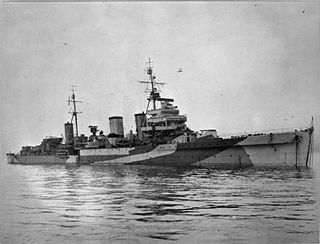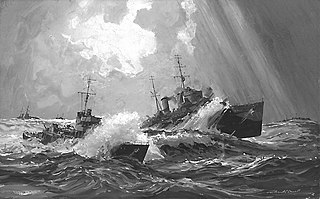
HMS Enterprise was one of two Emerald-class light cruisers built for the Royal Navy. She was built by John Brown & Company, with the keel being laid down on 28 June 1918. She was launched on 23 December 1919, and commissioned on 7 April 1926. She was the 14th ship to serve with the Royal Navy to carry the name Enterprise, a name which is still used in the Royal Navy today.

Operation Stonewall was a naval operation in the Second World War from 26 to 27 December 1943 to intercept blockade-runners off the west coast of German-occupied France. It was an example of good inter-service and inter-Allied co-operation.

The Battle of Ushant, also known as the Battle of Brittany, occurred on the early morning of 9 June 1944 and was an engagement between German and Allied destroyer flotillas off the coast of Brittany. The action came shortly after the initial Allied landings in Normandy. After a confused engagement during the night the Allies sank one of the German destroyers and forced another ashore, where she was wrecked.

Z23 was one of fifteen Type 1936A destroyers built for the Kriegsmarine during World War II. Completed in 1940, the ship spent the war in Norwegian and French waters, escorting German ships and occasionally engaging Allied warships. In early 1941 she escorted ships between the Baltic and southern Norway before spending four months protecting ships as they transited through the Bay of Biscay. A few months after the Operation Barbarossa began in June, Z23 was transferred to northern Norway where she attempted to intercept one of the Arctic convoys returning from the Soviet Union and helped to lay several minefields.

Z24 was one of fifteen Type 1936A destroyers built for the Kriegsmarine during World War II. Completed in 1940, the ship spent the first half of the war in Norwegian waters. She was very active in attacking the Arctic convoys ferrying war materials to the Soviet Union in 1941–1942, but only helped to sink one Allied ship herself.

Z27 was one of fifteen Type 1936A destroyers built for the Kriegsmarine during World War II. Completed in 1941, the ship was transferred to Norwegian waters later that year where she remained for most of the next several years, escorting convoys and laying minefields. She sank a Soviet oil tanker in late 1942 before sailing to Germany for a refit. Upon its completion in mid-1943, Z27 returned to Norway and participated in Operation Zitronella, the raid on the island of Spitsbergen in September.

The German torpedo boat T25 was one of fifteen Type 39 torpedo boats built for the Kriegsmarine during World War II. Completed in late 1942, she was transferred to France in July 1943. T25 was unsuccessfully attacked by Allied motor torpedo boats and aircraft during her voyage down the English Channel and then came to the aid of a convoy being attacked by Allied destroyers. Later that year she escorted blockade runners and Axis submarines through the Bay of Biscay. T25 also helped to lay minefields in the English Channel in mid-1943. She participated in the Battle of Sept-Îles in October and was sunk two months later by British light cruisers during the Battle of the Bay of Biscay.

The German torpedo boat T26 was one of fifteen Type 39 torpedo boats built for the Kriegsmarine during World War II. Completed in early 1943, the boat was transferred to France in August. T26 helped to lay a minefield in the English Channel the following month, and later escorted a blockade runner through the Bay of Biscay. She participated in the Battle of Sept-Îles in October and was sunk two months later by a British light cruiser during the Battle of the Bay of Biscay.

ZH1 was the lead ship of her class of four destroyers built for the Royal Netherlands Navy in the late 1930s. Originally named Gerard Callenburgh, the ship was scuttled while still incomplete by the Dutch during the German invasion of the Netherlands in May 1940, but she was salvaged by the Germans a few months later and commissioned in the Kriegsmarine in 1942 as ZH1.

The Battle of Sept-Îles was a naval action fought on the night of 22/23 October 1943 during World War II as part of the Atlantic campaign. The battle took place off the Sept-Îles near the French coast in the English Channel between a light cruiser and six destroyers of the British Royal Navy hoping to intercept, a German blockade runner, which was accompanied by German torpedo-boat destroyers flotillas of the German Kriegsmarine. In fact, it is likely that the British vessels were caught in an ambush, and the action ended with the sinking of HMS Charybdis and the scuttling of Hunt-class destroyer HMS Limbourne after suffering damage; over 500 British sailors lost their lives. The battle was the last surface fleet action of the war where the Royal Navy was defeated, and the last German surface fleet action victory.

Z32 was a German Type 1936A (Mob) destroyer, which was completed in 1942 and which served with the 8th Destroyer Flotilla of the Kriegsmarine during the Second World War. She fought in the Battle of the Bay of Biscay against HMS Glasgow and HMS Enterprise, alongside the German 8th Destroyer Flotilla and the 4th Torpedo Boat Flotilla. She mainly operated from German-occupied French Atlantic ports, escorting blockade runners and U-boats, and was sunk during the Battle of Ushant on 9 June 1944.

Z37 was a Type 1936A (Mob) destroyer built for the Kriegsmarine during World War II. Completed in 1942, the ship spent most of her brief career deployed in France. She participated in the Battle of the Bay of Biscay at the end of 1943 before she was accidentally rammed by the destroyer Z32 in early 1944. Towed back to port, the Kriegsmarine decided that Z37 was too badly damaged to repair and disarmed her hulk. Decommissioned later that year, she was scuttled by her crew before being scrapped by the French in 1949.

Kondor was the fifth of six Type 23 torpedo boats built for the German Navy. The boat made multiple non-intervention patrols during the Spanish Civil War in the late 1930s. During World War II, she played a minor role in the attack on Oslo, the capital of Norway, during the Norwegian Campaign of 1940. Kondor spent the next several months escorting minelayers as they laid minefields and damaged heavy ships back to Germany before she was transferred to France around September. She started laying minefields herself that month and continued to do so for the rest of the war. The boat returned to France in 1942 and helped to escort blockade runners, commerce raiders and submarines through the English Channel and the Bay of Biscay. Damaged by a mine shortly before the Allied Invasion of Normandy in June 1944, Kondor was under repair on the day of the landings. Recognizing that she could not be repaired quickly, the boat was decommissioned later that month and was then further damaged by British bombers so that she was declared a constructive total loss.

The Type 1939 torpedo boats, also known as the Elbing class by the Allies, were a group of 15 torpedo boats that were built for Nazi Germany's Kriegsmarine during World War II.

The German torpedo boat T24 was one of fifteen Type 39 torpedo boats built for the Kriegsmarine during World War II. Completed in 1942, the boat was briefly assigned to Norway in early 1943 before she was transferred to France in July. T24 was unsuccessfully attacked by Allied motor torpedo boats and aircraft during her voyage down the English Channel and then came to the aid of a convoy being attacked by Allied destroyers. Later that year she escorted blockade runners and Axis submarines through the Bay of Biscay. The boat played a minor role in the Battle of the Bay of Biscay and was lightly damaged during the action of 26 April 1944. During the subsequent battle, T24 sank a Canadian destroyer and was damaged when she later struck a mine. She played a minor role in the Battle of Ushant in June and was then damaged defending a convoy in August in the Bay of Biscay. T24 was sunk off the French coast later that month by Allied fighter-bombers.

The German torpedo boat T27 was one of fifteen Type 39 torpedo boats built for the Kriegsmarine during World War II. Completed in early 1943, the boat was transferred to France in August. T27 helped to lay a minefield in the English Channel the following month, and later escorted a blockade runner through the Bay of Biscay. She participated in the Battle of Sept-Îles in October and played a minor role in the Battle of the Bay of Biscay. The boat was lightly damaged during the action of 26 April 1944 off the coast of Brittany and ran aground during the subsequent battle two days later. Her wreck was destroyed shortly afterwards by the British.

The German torpedo boat T22 was one of fifteen Type 39 torpedo boats built for the Kriegsmarine during World War II. Completed in early 1942, the ship was transferred to France later that year where she escorted blockade runners and Axis submarines through the Bay of Biscay. T22 also laid minefields in the English Channel in mid-1943. She participated in the Battle of Sept-Îles, where she crippled a British destroyer, and the Battle of the Bay of Biscay later that year. After returning to Germany in early 1944, T22 struck a pair of mines in Narva Bay in August and blew up, with the loss of 143 men.

The German torpedo boat T23 was one of fifteen Type 39 torpedo boats built for the Kriegsmarine during World War II. Completed in mid-1942, the boat was stationed in France later that year where she escorted blockade runners and U-boats through the Bay of Biscay. T23 also laid minefields in the English Channel in mid-1943. She participated in the Battle of Sept-Îles and the Battle of the Bay of Biscay later that year, neither receiving nor inflicting any damage.
HMS Talybont was a Type III Hunt-class escort destroyer who served in the Royal Navy. She was launched in February 1943 and completed in May that year, serving for the rest of the Second World War. She took part in the Normandy Landings in June 1944, supporting the landings at Omaha Beach and the Pointe du Hoc. Post war she served in the Mediterranean before being reduced to reserve at the end of 1947. She was sold for scrap in 1961, with disposal completed by 1962.

HMS Limbourne (L57) was a Hunt-class escort destroyer, operated by the Royal Navy. She was sunk in action, off German-occupied Guernsey, on 23 October 1943.















